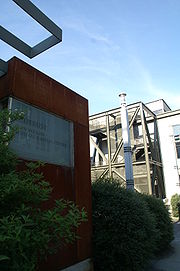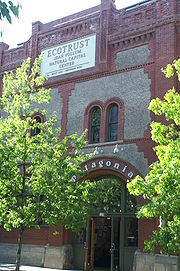
Natural Capital Center
Encyclopedia


Green building
Green building refers to a structure and using process that is environmentally responsible and resource-efficient throughout a building's life-cycle: from siting to design, construction, operation, maintenance, renovation, and demolition...
in Portland, Oregon
Portland, Oregon
Portland is a city located in the Pacific Northwest, near the confluence of the Willamette and Columbia rivers in the U.S. state of Oregon. As of the 2010 Census, it had a population of 583,776, making it the 29th most populous city in the United States...
, United States
United States
The United States of America is a federal constitutional republic comprising fifty states and a federal district...
. It was the first historic redevelopment in the U.S. to receive a gold-level Leadership in Energy and Environmental Design (LEED) award from the U.S. Green Building Council
United States Green Building Council
The U.S. Green Building Council , co-founded by Mike Italiano, David Gottfried and Rick Fedrizzi in 1993, is a non-profit trade organization that promotes sustainability in how buildings are designed, built, and operated...
. The building houses a unique mix of public and private, nonprofit and for-profit tenants, all of whom espouse social and environmental missions.
History and redevelopment
The timber and brick structure that is now Natural Capital Center was built in 1895 by the J. McCraken Company. The building's recessed rounded-arch entry, arched window openings and massive heft exemplify the Romanesque styleRomanesque architecture
Romanesque architecture is an architectural style of Medieval Europe characterised by semi-circular arches. There is no consensus for the beginning date of the Romanesque architecture, with proposals ranging from the 6th to the 10th century. It developed in the 12th century into the Gothic style,...
inspired by architect Henry Hobson Richardson
Henry Hobson Richardson
Henry Hobson Richardson was a prominent American architect who designed buildings in Albany, Boston, Buffalo, Chicago, Pittsburgh, and other cities. The style he popularized is named for him: Richardsonian Romanesque...
. Situated between two railroad freight yards, the McCraken wholesale company distributed Monterey sand, Tenino
Tenino, Washington
Tenino is a city in Thurston County, Washington, United States. The population was 1,695 at the 2010 census.-History:Tenino was officially incorporated on July 24, 1906, though it existed as a rural community since the mid-19th century...
sandstone and other building supplies. In the 1930s, the building became known as the Central Truck Terminal and then from 1941 to 1997 housed the Rapid Transfer & Storage Company (von Hagen, 2003).
In 1998, Ecotrust
Ecotrust
Ecotrust is a conservation organization based in Portland, Oregon that works to foster prosperous communities along the West Coast of North America.-History and Programs:...
, a nonprofit conservation organization, purchased the building with a donation from then board member Jean Vollum. Redevelopment of the 70000 square feet (6,503.2 m²) building cost $12.4 million and was completed in September 2001. The idea that a conservation organization would shift focus from protecting forests and watersheds to participating in urban renewal was an unusual and controversial one. A primary champion was then Ecotrust board member Jane Jacobs
Jane Jacobs
Jane Jacobs, was an American-Canadian writer and activist with primary interest in communities and urban planning and decay. She is best known for The Death and Life of Great American Cities , a powerful critique of the urban renewal policies of the 1950s in the United States...
, author of The Death and Life of Great American Cities
The Death and Life of Great American Cities
The Death and Life of Great American Cities, by Jane Jacobs, is a greatly influential book on the subject of urban planning in the 20th century...
. Ecotrust council member Stewart Brand
Stewart Brand
Stewart Brand is an American writer, best known as editor of the Whole Earth Catalog. He founded a number of organizations including The WELL, the Global Business Network, and the Long Now Foundation...
, author of How Buildings Learn
How Buildings Learn
How Buildings Learn: What Happens After They’re Built is an illustrated book on the evolution of buildings and how buildings adapt to changing requirements over long periods. It was written by Stewart Brand and published by Viking Press in 1994...
, was another key supporter. Soon after the building's purchase, he guided a charrette to discuss potential systems designs and programmatic linkages for the building. That the environmental movement
Environmentalism
Environmentalism is a broad philosophy, ideology and social movement regarding concerns for environmental conservation and improvement of the health of the environment, particularly as the measure for this health seeks to incorporate the concerns of non-human elements...
should address the urban environment was later one of the key themes in Brand's 2005 article "Four Heresies."
Re-opened to the public in 2001, the building was named the Natural Capital Center to reflect the ideas in ecological economics
Ecological economics
Image:Sustainable development.svg|right|The three pillars of sustainability. Clickable.|275px|thumbpoly 138 194 148 219 164 240 182 257 219 277 263 291 261 311 264 331 272 351 283 366 300 383 316 394 287 408 261 417 224 424 182 426 154 423 119 415 87 403 58 385 40 368 24 347 17 328 13 309 16 286 26...
that nature's services
Ecosystem services
Humankind benefits from a multitude of resources and processes that are supplied by natural ecosystems. Collectively, these benefits are known as ecosystem services and include products like clean drinking water and processes such as the decomposition of wastes...
are basic to human existence and that natural capital
Natural capital
Natural capital is the extension of the economic notion of capital to goods and services relating to the natural environment. Natural capital is thus the stock of natural ecosystems that yields a flow of valuable ecosystem goods or services into the future...
is, along with financial and other forms of capital, a fundamental means of production. As the first LEED gold-certified building in the Pacific Northwest, the building has become an icon of Portland, Oregon's leadership in the field of sustainability
Sustainability
Sustainability is the capacity to endure. For humans, sustainability is the long-term maintenance of well being, which has environmental, economic, and social dimensions, and encompasses the concept of union, an interdependent relationship and mutual responsible position with all living and non...
. The mix of "green" tenants in the building—including Patagonia
Patagonia (clothing)
Patagonia, Inc. is a Ventura, California-based clothing company, focusing mainly on outdoor clothing. The company is a member of several environmental movements. It was founded by Yvon Chouinard in 1972....
, Hot Lips Pizza, ShoreBank Pacific, Portfolio 21, and the City of Portland's Office of Sustainable Development—has gained much attention and been cited as an inspiration for other developments planned around the country, including the Green Exchange
Green Exchange
The Green Exchange is a sustainable and green retail and office development project in the Logan Square community area of Chicago, Illinois that is designed to house more than one hundred eco-friendly businesses and organizations within a single building...
in Chicago.
It is located at 721 NW 9th Avenue, Portland, OR 97209.
Features
- Embodied energyEmbodied energyEmbodied energy is defined as the sum of energy inputs that was used in the work to make any product, from the point of extraction and refining materials, bringing it to market, and disposal / re-purposing of it...
- Owing to the large amount of energy that goes into materials manufacture, reuse of existing buildings is an important consideration in energy conservationEnergy conservationEnergy conservation refers to efforts made to reduce energy consumption. Energy conservation can be achieved through increased efficient energy use, in conjunction with decreased energy consumption and/or reduced consumption from conventional energy sources...
. At the Natural Capital Center opening ceremony, Patagonia founder Yvon ChouinardYvon ChouinardYvon Chouinard is a rock climber, environmentalist and outdoor industry businessman, noted for his contributions to climbing, climbing equipment and the outdoor gear business. His second company, Patagonia is known for its environmental focus...
said, "If you're going to buy clothing, the most responsible thing you can do is go to the Salvation ArmySalvation ArmyThe Salvation Army is a Protestant Christian church known for its thrift stores and charity work. It is an international movement that currently works in over a hundred countries....
. And if you're going to open a new business, the most responsible thing you can do is find an old building and restore it."
- DeconstructionDeconstruction (building)In the context of physical construction, deconstruction is the selective dismantlement of building components, specifically for re-use, recycling, and waste management. It differs from demolition where a site is cleared of its building by the most expedient means. Deconstruction has also been...
- An annex to the original building was deconstructed, and throughout the redevelopment, 98% of all debris was reused, recycled or reclaimed - a record for the city of Portland.
- Stormwater managementStormwaterStormwater is water that originates during precipitation events. It may also be used to apply to water that originates with snowmelt that enters the stormwater system...
- The building utilizes a green roofGreen roofA green roof is a roof of a building that is partially or completely covered with vegetation and a growing medium, planted over a waterproofing membrane. It may also include additional layers such as a root barrier and drainage and irrigation systems...
, permeable pavement and bioswaleBioswaleBioswales are landscape elements designed to remove silt and pollution from surface runoff water. They consist of a swaled drainage course with gently sloped sides and filled with vegetation, compost and/or riprap...
s to retain an estimated 95% of the property's stormwater onsite.
- Land use - The building is located in a high density area, with close access to public transportation. The parking lot is used as a farmer's market once a week in the summer.
- Materials - Two-thirds of the new wood used in the building was Forest Stewardship CouncilForest Stewardship CouncilThe Forest Stewardship Council is an international not-for-profit, multi-stakeholder organization established in 1993 to promote responsible management of the world’s forests. Its main tools for achieving this are standard setting, independent certification and labeling of forest products...
(FSC) certified. Innovative materials include rubber flooring from post-consumer recycled rubber tires.
- LEED rating - The building received 41 of 69 possible points.
Further reading
- "Building on Ideas for Urban Conservation." Linda Baker. New York Times. March 4, 2001. Accessed May 10, 2007.
- "Case Study: Ecotrust Building Renovation" Interface Engineering. Accessed May 10, 2007.
- "Historic Preservation and Green Building: A Lasting Relationship." Tristan Roberts. Environmental Building News. January 2007. Accessed May 10, 2007.
- Rebuilt Green: The Natural Capital Center and the Transformative Power of Building. Von Hagen, Bettina, Erin Kellogg and Eugenie Frerichs, editors. 2003, Ecotrust, 120 pages, ISBN 0-9676364-2-6. Accessed May 10, 2007.

